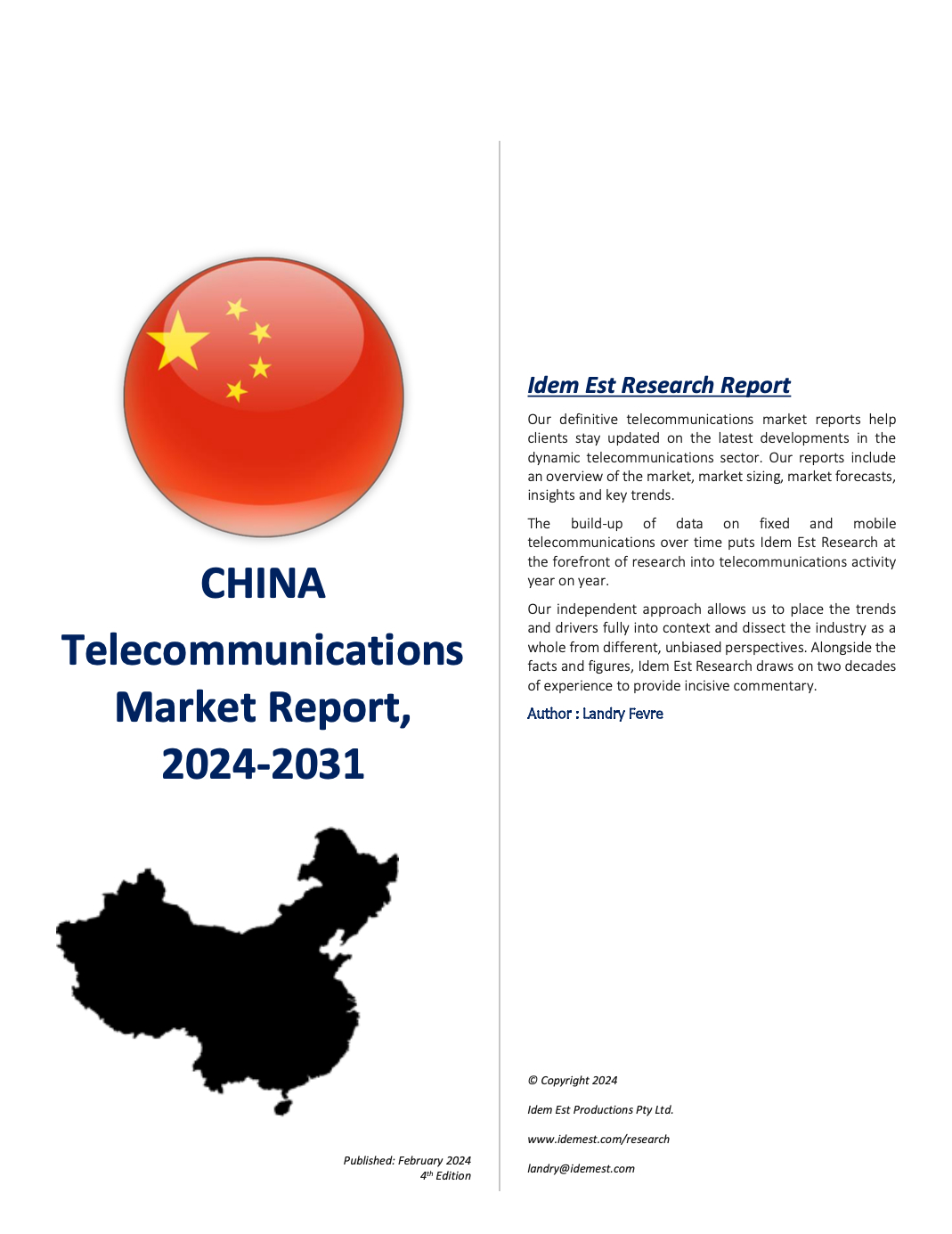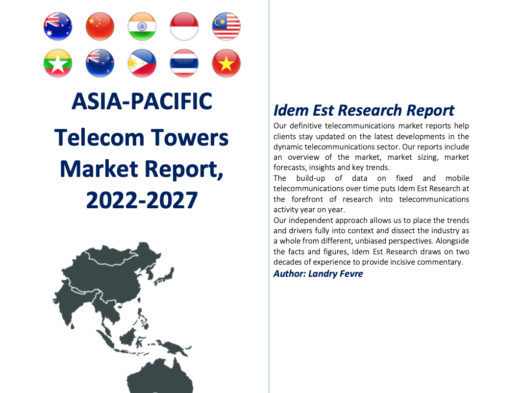Description
WHY YOU SHOULD BUY THE CHINA TELECOMS INDUSTRY REPORT:
- Benefit from the latest market opportunities
- Understand the threats to your operations and investments and protect your company against future risks
- Gain insights on emerging trends supporting, enhancing or disrupting your activities in the market
- Get a full view of the competitive landscape to assess your market position.
- Forecasts as a key input for successful budgeting and strategic business planning in the telecoms market
- Target business opportunities and risks in the telecoms sector through our reviews of latest industry trends, regulatory changes and major deals, projects and investments
- Assess the activities, strategy and market position of your competitors, partners and clients via our Operators Profiles
The China Telecommunications Industry Report, 2023-2028 includes a comprehensive review of the Chinese market dynamics, market sizing, market forecasts, analysis, insights and key trends.
EXECUTIVE SUMMARY
China Telecoms Industry Report at a Glance
In China, the telecommunications sector has garnered special attention due to its role in facilitating national development, enhancing global competitiveness, and supporting the government’s strategic goals, including the ambitious “China Dream” initiative which aims at national rejuvenation through technological supremacy.
China Telecoms Industry Report – Strategic Importance and Growth Forecasts
China’s telecom industry is recognized for its resilience amidst global economic uncertainties and political tensions. This is attributed to the essential nature of telecom services.
Idem Est Research projects steady growth for the Chinese telecom sector, driven by the increasing penetration of mobile phones and a high uptake of fixed broadband among households. This growth is not only supported by the expansion of the consumer base but also by substantial investments in infrastructure, particularly in 5G technologies, which are set to redefine the landscape of digital connectivity and innovation.
Mobile and Broadband Penetration
The past decade has seen a dramatic increase in internet users in China, with hundreds of millions of new users coming online. This trend is expected to continue, fueled by the growing accessibility and affordability of mobile and broadband services. The report anticipates significant growth in mobile subscriptions and fixed broadband subscribers, underlining the crucial role of telecommunications in enhancing digital inclusion and economic growth.
Despite a declining population and economic uncertainties, the sector is forecasted to experience sustained revenue growth. This optimism is partly due to the Chinese government’s strategic investments in telecom infrastructure, aiming to bolster the national economy and strengthen social cohesion through improved connectivity.
Government Influence and International Competition
The Chinese government plays a pivotal role in the telecom industry, holding substantial shares in the three major Telecommunications Service Providers (TSPs). This unique position allows the government to direct strategies, network investments, and pricing, emphasizing the development of a robust telecommunications infrastructure as a national priority.
Moreover, the strategic competition between the United States and China, especially in advanced technology sectors, places additional emphasis on the telecom industry. Achieving technological ascendancy is seen as crucial for gaining strategic and economic power, positioning the telecom sector at the heart of this international rivalry.
China Telecoms Industry Report – 5G Deployment and Capex Investments
The report highlights the cyclical nature of Capex investments in the telecom sector, with a particular focus on the rollout of 5G networks. As operators invest heavily in 5G, alongside enhancing 4G coverage and capacity, significant capital expenditure is anticipated, reflecting the sector’s commitment to supporting burgeoning data demand.
5G technology is not just seen as the next step in mobile connectivity but as the foundation for a range of technological advancements, including autonomous vehicles, smart cities, and the Internet of Things (IoT). The Chinese government’s directive for rapid 5G network construction, evidenced by the installation of millions of 5G base stations, underscores the strategic importance of 5G in China’s technological and economic ambitions.
China Telecoms Industry Report – Operator Profiles and Competitive Landscape
The Chinese mobile market is characterized by stability, with three major state-owned operators competing under government guidance. This unique setup has influenced network speed upgrades, mobile data tariffs, and future investment policies, including those related to 5G and Fiber to the Home (FTTH).
Revenue and market share dynamics among these operators reflect the competitive pressures and strategic shifts within the industry. For example, China Mobile’s growing dominance, China Telecom’s recovery in EBITDA, and China Unicom’s challenges highlight the ongoing transformation in the telecom landscape.
Challenges and Opportunities
While the telecom sector faces structural challenges, including declining voice and SMS revenues, the expansion of mobile and broadband services presents significant opportunities. The growth in mobile subscriptions, however, is expected to slow, intensifying competition among operators for a shrinking pool of new customers.
Pricing strategies, especially for mobile data, have seen considerable shifts, with China experiencing significant cost reductions per GB. This competitive pricing is essential for expanding access to digital services and fostering a more connected society.
Broadband and FTTH Developments
The fixed broadband market in China is witnessing robust growth, driven by aggressive expansion strategies from operators like China Mobile. With the majority of broadband subscribers opting for high-speed FTTH connections, China is making significant strides towards achieving gigabit-speed connectivity for its citizens.
Investment Landscape and Future Directions
The telecom infrastructure, encompassing mobile towers, data centers, and fiber networks, is attracting high valuation multiples from investors. This interest reflects the long-term value andStable growth in China’s telecommunications sector is underpinned by its crucial role in national economic infrastructure, with increasing investment attraction from infrastructure funds due to its critical nature in the connected world. The sector’s resilience is bolstered by growing mobile and broadband penetration, anticipated to drive future expansion. Despite political and economic uncertainties, Idem Est Research projects a steady trajectory for the industry, fueled by substantial internet user growth and sustained revenue increases. The government’s significant influence over telecom operators highlights its strategic importance in national development and global technological competition. Advanced 5G deployment, backed by significant Capex investments, underlines the sector’s pivotal role in technological advancements such as autonomous vehicles and smart cities. Moreover, the competitive landscape is shaped by the strategic rivalry between the US and China, emphasizing the telecom sector’s critical role in achieving technological supremacy and economic power.
According to our China Telecoms Report, Idem Est Research expects the Chinese telecommunications industry to remain steady thanks to the defensiveness nature of the industry, amid the political uncertainties and an uncertain economic outlook due to the COVID-19 pandemic.
Our China Telecoms Report transactions database analysis highlights the dearth of inbound (domestic) transactions in the Chinese telecommunications services market, with the largest transaction being the telecommunications operators shifting assets to an infrastructure entity, China Tower Co. However, in the short to medium term, the telco sector is unlikely to experience corporate activity with the government controlling the sector and with telecommunications remaining a strategic sector with a low level of debts. Most transactions are expected in the data centre, IoT and cloud computing sector with many private sector operators and large technology companies such as Tencent, Baidu, and Alibaba.
The arrival of 4G moved the Internet off our desktops into our palms and pockets, 5G could transform the network from something we carry around to something taking us around either virtually (augmented reality or virtual reality) or in reality (autonomous vehicles), the 5G outcome and benefits beyond fast connectivity remain largely unknown in terms of business models, investments required and timeline.
KEY COMPANIES MENTIONED IN THIS CHINA TELECOMS INDUSTRY REPORT:
Beijing RLZY, China Mobile, China Telecom, China Tower, China Unicom, Dr Peng, Guodong, Miteno, Sino Netstone, Tietong, Zhejiang WanXing
China Telecoms Industry Report – Table of Contents
1 Key Statistics
1.1 China Population
1.2 China’s Economy
1.3 China’s GDP
2 Overall Telecommunications Market, 2017–2031
2.1 Market Overview
2.2 China’s Race to Lead in 5G and Beyond
2.3 Historical Telecommunications Market Revenue, 2017-2023
2.4 Overall Telecommunications Market Forecast, 2023-2031
2.5 Telecommunications Market Capital Expenditure, 2017-2031
2.5.1 Historical Telecommunications Capex Spend, 2017-2023
2.5.2 Capex to Revenue Benchmark
2.5.3 Capex to GDP Benchmark
2.5.4 Telecommunications Capex Spend Forecast, 2023-2031
3 Telecommunications Operators Profile
3.1 China Mobile Profile
3.1.1 China Mobile Revenue, EBITDA and Capex Mix
3.2 China Unicom Profile
3.2.1 China Unicom Revenue and EBITDA Mix
3.3 China Telecom Profile
3.3.1 China Telecom Corporation Revenue, EBITDA and Capex Mix
4 Mobile Market
4.1 Mobile Subscribers Historical and Forecast, 2017-2031
4.1.1 Mobile Subscribers Historical, 2017-2023
4.1.2 Mobile Subscribers Market Share, 2017-2023
4.1.3 China Smartphone Share, 2024
4.1.4 China Mobile Subscribers Forecast, 2023-2031
4.1.5 China Mobile Subscribers by Generation (2G, 3G, 4G, 5G & 6G) Forecast, 2023-2031
4.2 Mobile Revenue Historical and Forecast, 2017-2031
4.2.1 Historical China Mobile Service Revenue, 2017-2023
4.2.2 Mobile Service Revenue Forecast, 2023–2031
4.2.3 Mobile Subscribers ARPU, 2017-2031
4.3 Spectrum Holdings
4.3.1 Spectrum Pricing and Regulation
4.3.2 5G Development and Launches
4.3.3 Mobile Frequencies Portfolios Analysis
4.3.1 Spectrum Depth Benchmark by Country
4.4 Mobile Download Data and Pricing Trends
4.5 Mobile Speed Tests
4.5.1 Ookla Mobile Speed Tests
4.6 Internet of Things (IoT)
5 Broadband Market
5.1 Fixed Broadband Subscribers Historical, 2017-2023
5.2 Fixed Broadband Subscribers Forecast, 2023-2031
6 Satellite Internet Connectivity
6.1 Comparing LEO, MEO, and GEO Satellite Orbits
6.1.1 LEO and GEO Satellite Comparison
6.2 Satellite Broadband Providers Operators, 2023
6.3 5G NTN: The Next Generation of Satellite Connectivity
6.3.1 5G NTN Overview
6.3.2 The Rationale Behind 5G NTN
6.3.3 Technical Aspects of 5G NTN
6.3.4 Potential Applications for 5G NTN
6.3.5 Challenges in Implementation
6.3.6 5G NTN Satellite Providers
6.4 Satellite Internet Market Analysis, 2022-2030
6.4.1 Market Landscape of Satellite Broadband Subscribers, 2022
6.5 China Satellite Broadband Subscribers Forecast, 2022-2030
7 Telecommunications Infrastructure Investments
7.1 Fixed Digital Infrastructure
7.1.1 Government Plans
7.1.2 Submarine Cables
8 China Telecom Towers Infrastructure Landscape
8.1 China Telecom Tower Market Analysis, 2023
8.1.1 China Telecom Tower Market Overview
8.1.2 China Telecom Towers Background
8.2 China Telecom Towers Market Competitive Landscape Comparison
8.3 China Telecom Tower & Rooftops Market Forecast
8.3.1 China Telecom Towers and Rooftops, Revenue, Penetration Forecast, 2022-2030
8.3.2 Regulatory Considerations
8.4 China Tower Co Profile
8.4.1 China Tower Co Revenue, EBITDA and Capex, 2016 – 2022
8.4.2 China Tower Key Performance Indicators
8.5 Guodong Profile
8.5.1 Guodong Towers Key Performance Indicators
8.6 Miteno Profile
8.6.1 Miteno Towers Key Performance Indicators
8.7 Sino Netstone Profile
8.7.1 Sino Netstone Towers Key Performance Indicators
8.8 Telco Infrastructure Comparative
9 Thematics / Opportunities
9.1 Consolidation Opportunities
9.2 Diversification Opportunities
9.2.1 e-Commerce
9.3 New Telecoms Operating Model
9.3.1 The Attraction of Infrastructure Multiples
9.4 6G Developments
10 Telco M&A Transaction Database
11 Methodology
12 Copyright Notice
China Telecoms Industry Report – List of Figures
Figure 1 – Telco sector revenue as % of GDP in China
Figure 2 –Revenue Profile Historical Mix (CNY bn), 2017 – 2023
Figure 3 – Telecommunications Market Revenue Pool, 2023
Figure 4 – Telecommunications Market EBITDA Pool, 2023
Figure 5 – Telecommunications Revenue & EBITDA Share Estimates, 2023
Figure 6 – Total Telecoms Market Revenue and Growth Rate (CNY bn), 2023-2031
Figure 7 – Capex to Revenue Benchmark, 2017-2023
Figure 8 – Capex to GDP Ratio Benchmark, 2017-2023
Figure 9 – Telecommunications Capital Expenditure Spend, 2000-2031
Figure 10 – China Mobile Service Revenue Mix, 2017-2023
Figure 11 – China Mobile Historical Revenue Mix, 2017 – 2023 (CNY m)
Figure 12 – China Unicom Service Revenue Mix, 2017-2023
Figure 13 – China Unicom Historical Revenue Mix, 2017 – 2023 (CNY m)
Figure 14 – China Telecom Service Revenue Mix, 2017-2023
Figure 15 – China Telecom Historical Revenue Mix, 2015 – 2021 (CNY m)
Figure 16 – Mobile Subscribers Share Comparison, 2017-2023
Figure 17 – Mobile Subscriber Share Comparison, 2017-2023
Figure 18 – Mobile Net Adds (000’s) Comparison, 2017-2023
Figure 19 – Mobile Subscribers Forecast, 2017-2023
Figure 20 – China Mobile Subscribers by Generation (2G, 3G, 4G, 5G & 6G) Forecast, 2023-2031
Figure 21 – Mobile Service Revenue Forecast (CNY bn), 2017-2031
Figure 22 – Mobile Subscribers ARPU (CNY), 2017-2031
Figure 23 – Mobile Frequencies by Operators and by Band (MHz)
Figure 24 – Subscriptions per MHz of Spectrum, Emerging Asia-Pacific Countries, 2023
Figure 25 –Mobile Handsets Monthly Download Data, 2017-2023
Figure 26 – Data Pricing Trends in Asia-Pacific (USD per GB per month), 2017-2023
Figure 27 – Spectrum Available and IoT Landscape in China
Figure 28 – Broadband Subscribers Share Comparison, 2017-2023
Figure 29 – China Net-Adds (000’s) by Operators, 2017-2023
Figure 30 – Broadband Subscribers Forecast, 2017-2031
Figure 31 – Satellite Deployments Type
Figure 32 –Starlink and OneWeb Satellite Launches per Month (Data until Jan-24)
Figure 33 – Asia Pacific Satellite Broadband Subscribers Forecast, 2022-2030
Figure 34 – China Telecom Towers Market Share, 2023
Figure 35 – China Telecom Towers & Rooftops Forecast, 2022-2030
Figure 36 – Telecoms Providers EV/EBITDA Ranges
China Telecoms Industry Report – List of Tables
Table 1 – China – Key Statistics
Table 2 – Telecommunications Market Revenue by Operators, 2017-2023
Table 3 – Total Telecommunications Market Revenue, 2023-2031
Table 4 – Historical Telecommunications Capex Spend, 2017-2023
Table 5 – Total Telecommunications Capex Investments Forecast, 2023-2031
Table 6 – Historical China Mobile Revenue, EBITDA and Capex, 2017-2023
Table 7 – Historical China Unicom Revenue, EBITDA and Capex Mix, 2017-2023
Table 8 – Historical China Telecom Revenue, EBITDA and Capex Mix, 20157-2023
Table 9 – Historical Mobile Subscribers, 2017-2023
Table 10 – China Mobile Subscribers Forecast, 2021-2028
Table 11 – China Mobile Subscribers by Generation (2G, 3G, 4G, 5G & 6G) Forecast, 2023-2031
Table 12 – Historical Mobile Service Revenue, 2017-2023
Table 13 – Mobile Service Revenue Forecast, 2023-2031
Table 14 – Historical Mobile Market Blended Mobile ARPU, 2017-2023
Table 15 – Spectrum Holdings by Operators and by Bands (MHz)
Table 16 – Historical Broadband Subscribers, 2017-2023
Table 17 – Historical Broadband Monthly ARPU, 2017-2023
Table 18 – China Broadband Subscribers Forecast, 2023-2031
Table 19 – Satellite Orbit Altitudes
Table 20 – Satellite Broadband Subscribers Operators, 2024
Table 21 – 5G NTN and Satellite Providers, 2023
Table 22 – China Satellite Broadband Subscribers Forecast, 2024-2030
Table 23 – International Submarine Cable Systems with Landing Stations in China
Table 24 – China Telecom Towers Market Analysis, 2023
Table 25 – China Telecom Towers Indicative Tower Leasing Annual Fees
Table 26 – China Telecom Towers Market Competitive Landscape Comparison
Table 27 – China Telecom Towers, Revenue, Mobile Subscribers, Penetration & ARPU Forecast, 2022-2030
Table 28 – Historical China Tower Co Revenue, EBITDA & Capex, 2016-2022
Table 29 – China Tower Key Performance Indicators, 2023
Table 30 – Guodong Towers Key Performance Indicators, 2023
Table 31 – Miteno Towers Key Performance Indicators, 2023
Table 32 – Sino Netstone Towers Key Performance Indicators, 2023
Table 33 – China Mobile, China Unicom, China Telecom, China Tower and Guodong Infrastructure Landscape
Table 34 – Telco Transaction Database, 2009-2023
Other Idem Est Research Telecoms Country Reports
Australia, Bangladesh, China, India, Indonesia, Japan, New Zealand, Malaysia, Myanmar, Pakistan, Philippines, Singapore, South Korea, Taiwan, Thailand, Vietnam,
Asia Pacific Telecom Towers, Starlink Company Profile






